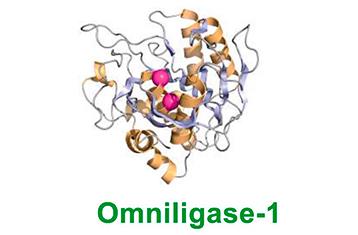Welcome to Iris Biotech
For better service please confirm your country and language we detected.
confirm selection

For better service please confirm your country and language we detected.

Thank you very much for your interest in our products. All prices listed on our website are ex-works, Germany, and may attract customs duties when imported.
You may/will be contacted by the shipping company for additional documentation that may be required by the US Customs for clearance.
We offer you the convenience of buying through a local partner, Peptide Solutions LLC who can import the shipment as well as prepay the customs duties and brokerage on your behalf and provide the convenience of a domestic sale.
Continue to Iris Biotech GmbHSend request to US distributorPublished on 19/07/2016

A modified version of subtilisin from B. subtilis, Omniligase-1 (developed by EnzyPep B.V.) has been selected to ligate side-chain unprotected peptide segments. Unlike classical Native Chemical Ligation, the approach using Omniligase is not limited to fragments bearing an N-terminal cysteine.
Omniligase-1 catalyzes the reaction between an ester fragment (acyl donor) and an amine (acyl acceptor, nucleophile) fragment. The enzyme can be used to either cyclize a single peptide ester fragment, or to ligate two fragments. In the latter case, the N-terminus of the peptide ester fragment has to be protected in order to avoid cyclization. Ligation proceeds under mild aqueous conditions without racemization, with ligation yields as high as 98.9%.
Due to its broad substrate specificity, Omniligase-1 recognizes many different kinds of acyl donors. Alkyl-, aryl- and thioesters can all be used as peptide ester fragment. However, we recommend carboxyamidomethyl (Cam) esters, or substituted derivatives thereof (e.g. –Cam-Leu-OH or –Cam-Leu-NH2). Peptide Cam-esters (and derivatives) can be prepared by standard solid-phase techniques. If necessary, the polarity and hence solubility of the peptide ester fragment can be tuned by changing the type of C-terminal ester.
For ligation of two fragments, the peptide ester fragment must bear an N-terminal protecting group to avoid unwanted cyclization. For this purpose, we recommend the phenylacetyl group, which can be removed under mild conditions using commercially available acylases (e.g. immobilized PenG amidase from Iris Biotech: EZ60030, EZ60040).
The amine (acyl acceptor, nucleophile) fragment requires no further modifications and can be used completely unprotected.
Omniligase-1 has six substrate recognition subsites: four at the acyl donor binding site (S1-S4), and two at the amine site (S1' and S2'). The substrate scope of omniligase-1, which has been completely determined, is very broad.
With the exception of proline in the S1, S2, S1’ and S2’sites, the enzyme tolerates every amino acid in all of the substrate binding sites. The ligation yield largely depends on the nature of the amino acids in the S1’ and S2’ pockets. Asp and Glu should be avoided at the S2’ position, because ligation will result in lower yield. In summary there are many options of amino acid fragment combinations which enable ligation yields of over 70%.
OMNI Kit components may be used for research purposes only. They may not be used for any other purpose, including, but not limited to, use in drugs, in vitro diagnostics purposes, therapeutics or in humans. EnzyPep products may not be transferred to third parties, sold, resold, modified for resale, or used to manufacture commercial products or to provide a service to third parties without written approval of EnzyPep BV.